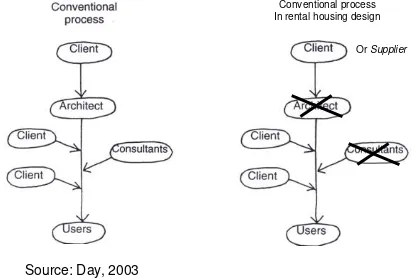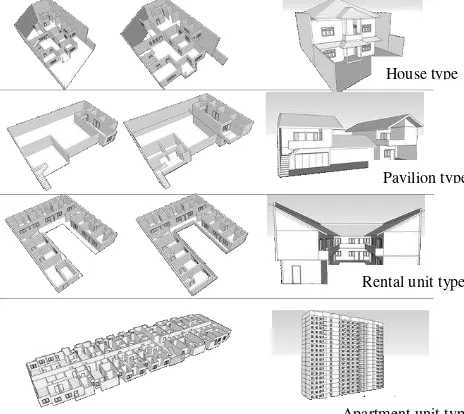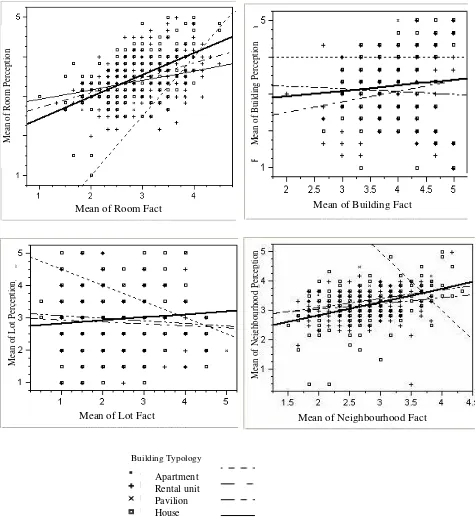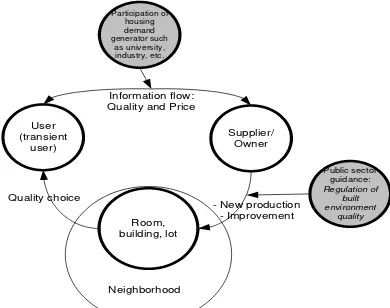Abstract— Stake-holders participation in the process and evaluation of spatial quality development indicates the existence of collaboration in spatial design. In rental housing design, the collaboration technique is rarely studied. Identification of the renter aspiration and the owner interest, as the key stake-holder with different motives in rental housing development, is essential. One method of renters’ involvement to achieve quality housing is study of renter’s perception about their housing attributes. This method is called effect-based valuation. Meanwhile, the method to acquire value from the owner side is conducted through assessment of rental housing fact, which is called exposure-based valuation.
The comparison of the two valuations is important to identify the housing design performance from the user point of view, and to discover the housing form from the owner side. Through these approaches, the spatial quality criteria are combined for future design improvement. Hypothetically, the renter with critical judgment will give good value for maximum condition, and in contrary, they will give bad value for minimum one. This paper describes the combination of two spatial valuations: renter perception and factual measurements as an alternative method of collaboration in rental housing design. For this objective, students’ rental housing in Bandung is used as a case study. It is identified that collaboration for rental housing design potentially hampered by some factors from both renter and owner side. It is also concluded about the concept of rental housing design to meet the renter need and the owner interest, and to reduce the hampered factors from both sides.
Index Term— collaborative design, factual valuation, rental housing, user perception
I. INTRODUCTION
The need of housing in urban context has been growing rapidly as fast as the increase of population rate. One of the housing facilities that its demand has been highly increase is rental housing, which is present in market mechanism as an alternative of housing tenure. Some influence factors for household to choose rental housing [1] are: 1) changing of demographic and social economic pattern, 2) type and quality of housing in rental housing market, 3) security of housing and management system, and 4) affordability, quality of infrastructure, acessibility, and other facilities. Rental housing market gives alternative for consumer to choose certain quality and price based on their need and affordability.
This article was presented in Arte-polis3 International Conference, held in Bandung, Indonesia 22-24 July 2010
In line with development of rental housing market, the consumer satisfaction becomes an important focus for supplier to make their product saleable. Rental housing production that formerly focused only on supplier interest, have been moved gradually into consumer satisfaction [2]. Consumer satisfaction or dissatisfaction of housing product indicates performance of supplier capacity and performance of their housing design.
Collaborating consumer perspective into rental housing production is essential to achieve quality rental housing. The term of design participation, community participation, community architecture, advocacy, neighborhood planning, community planning, community-based development, etc., for each term there is a body of associated work: writing and action. Each has its own qualities, whether defined by scale, method, motive or degree of involvement – some terms subsuming others. What they all share is the principle that non-professionals are involved, to some degree, in decision making about built environment, including housing, which will affect them [3]. Unfortunately, collaboration for housing design is
already common term for ‘project owner’ or ‘housing owner’, used to called local communities, but not for ‘transient user’ or ‘housing renter’. Since the paradigm of housing user (especially in rental housing) is differentiated into ‘the owner or supplier’ and ‘the transient consumer’, it remains some
challenge to define design collaboration in housing for rental purposes. This paper is positioned to describe the opportunity
of incorporating ‘transient user’ into housing development,
especially for rental housing.
The description of this paper based on secondary data analysis which is reflection of case study and research method from author doctoral research that has finished in 2009, and stake holder study on rental housing production. Level of discussion is limited on rental housing design issues and the challenge of key actors collaboration challenge using students’ rental housing as a case study.
II. RENTALHOUSINGISSUES
A. Transient Housing and Transient User as Part of Human Life-Cycle
Housing as part of basic need for everyone is related to human life-cycle which is traditionally divided into five stages [4] : 1) phase of bachelorhood, when the young people leave
their parents’ house, 2) phase of honeymooners, when the
young couple start their new family, 3) phase of parenthood, when the married couple have some children, 4) phase of post-parenthood, when the old couple was leaved by their adult son/daughter, and 5) phase of dissolution, when the old people
Incorporating User for Rental Housing Design
Case Study: City of Bandung, Indonesia
start their widow-hood phase. From these cycles, it is recognized about complexity of housing need, including variety of its tenure status (rental, owner, etc.), variety of its location, variety of its type, or variety of its quality. Since to house is a basic need, the availability of housing choice including transient one for every people or every family in different life-cycle is essential. The choice in moral context is associated to autonomy, freedom and responsibility of every people or every family [5]. Inhibition on people or family choice potentially hampers their role and their responsibility to maintain quality of their daily space.
B. Design Process and Its Issues
Rental housing can be defined as dwelling which its unit is rented by the owner to the consumer. Rental housing is characterized as infestation commodity from the supplier side to gain profit maximally. The owner and the renter are doing transaction in acceptable housing condition and price based on market mechanism.
From user side, to house in rental tenure-ship occur because of some factors: 1) un-ability to obtain home ownership, 2) the need of housing temporary for specific period in certain location [6], and 3) preference to house in rental-ship than ownership. Some influence factors for household to choose rental housing are: 1) changing of demographic and social economic pattern, 2) type and quality of housing in rental housing market, 3) security of housing and management system, and 4) affordability, quality of infrastructures, accessibility, and other facilities. Rental housing market gives alternative for consumer to choose quality and price, so they can make housing decision according to their need and their affordability.
The housing transformation including rental houses consists of three steps: 1) Restoration: by minimal changing of existing housing element, for example addition of minor flat roof, placing a door into empty wall, and repainting; 2) Remodeling: by changing housing form especially the façade appearance, but it’s still using the existing building structure. For example: changing new element to cover old element such as using the modern element of roof and coverage the old roof; and 3) Reconstruction: by totally changing former housing and leave the old images.
Compare with own-housing status, rental housing has been developing lately in the way of its production process, its product/design form, and its mechanism of occupation and maintenance. Similar with that process, the idea of collaboration in development of housing and environment has been arise since 1960. Unfortunately, collaboration is a common term of housing design for permanent user, used to called local communities, but it’s not for transient user. It is believed that the existent of multi-stakeholder collaboration in housing design will increase the environment maintenance responsibility and sustainability, and it remain lack of understanding about transient user participation in housing development.
III. THESTAKEHOLDER AND RENTALHOUSING DESIGN PROCESS
Recently in Indonesia context, the single actor in rental housing design is the owner or the supplier. Major of supplier produce rental housing without architect services and any guidance from the public sector, therefore majority of rental housing product is representing preferences and capacity of the supplier rather than other stakeholders. The user or the consumer is still has not any influence into the design process of rental housing. If we map this process of rental housing according to the design process in Day [3], 2003, we can see as illustrated on Figure 1.
Fig. 1. Comparison of conventional process of design in general and rental housing in Indonesia
The next type of design process is participation design. According to Day (2003), there is a basic difference between participation process and consensus one: the aspiration input from user in design decision making (see Figure 2). The ideal process of design collaboration is the consensus type, which the users involve as equal as the client (supplier) in earlier step. To arrive at the situation of consensus process, the user capacity in participation process is essential, and the initial requirement for user to participate is can perceive value of housing quality in critical way.
Consumer with critical judgment to state their aspiration is very important to increase the quality of rental housing product. Congruency of consumer aspiration and rental housing product indicates successful market mechanism to fulfill consumer need of rental housing, and indicates successful of space or place design [7][8][9]. Hypothetically, rational consumer will choose housing with good quality and leave housing with poor condition, so the increasing of product quality by supplier will gradually exist [10]. Actually, not every consumer can value and choose their housing in critical way, because they are hampered by some factor. The case
study about students’ rental housing will give us some
understanding about the collaboration prospect of transient user and supplier.
Conventional process In rental housing design
Source: Day, 2003
Fig. 2. Participation process and consensus process (Source: Day, 2003)
There are several studies that compare factual and perceived quality on occupancy, including Day, 2000; Ozaki, 2002; Al-Momani, 2003 and Majumder et.al, 2007. Each researcher developed a different housing attributes to review the suitability or the gap between residential quality of factual and perception. The substance of the studies reviewed based on the attributes of housing that includes:
1) suitability or the gap between residential facts (represented by two types of dwelling: house on small plots and vertical residential/apartment) and the satisfaction of each customer based on two groups of attributes, i.e. plans site and design of residential [11];
2) suitability or gaps between facts and perceptions of residential consumers in the three groups of attributes: quality workmanship, service delivery, and housing design [10];
3) suitability or gaps between facts and perceptions of residential consumers in the three groups of attributes: residential design, consumer activity contained and cultural relevance population [12];
4) suitability or gaps between facts and perceptions of residential consumers about the quality of environment, including physical environment (flood, air quality, vegetation, noise, congestion, danger factor, etc.), environmental facilities (clean water, electricity, gas, telephone, sanitation, waste disposal, waste management, health, education, workplace, etc.) and social environment (social activity, privacy, community action, public awareness, etc.) [13].
Research conducted by Day, Ozaki, Al-Momani and Majumder provide an understanding of: 1) consumer behavior as a referral option to increase housing production in the market mechanism, 2) Knowledge of optimal design in accordance with the characteristics of residential consumers, both socio-economic or socio-cultural character, 3) Knowledge about the prospects for the application of indicators for assessing perceptions of housing quality. The research for this purpose is relatively rare in the context of housing needs in Indonesia, particularly rental housing in accordance with market mechanisms.
IV. CASESTUDY:STUDENTSRENTALHOUSING
To identify the prospect of user participation in rental housing design, the study of student rental housing is conducted as a case study. Two approaches, factual and perceptual ones were implemented. Factual approach is called objective way to analyze rental housing which consists of housing spread around university site, building design, condition of housing attribute which reflect capacity of supplier to accommodate students demand, and rental price. Meanwhile, perceptual approach is the method to analyze
students’ perception as consumer to their rental housing
quality.
Factual approach is conducted through typology study of building and neighborhood and market price analysis, while
the perceptual one is conducted through analysis of students’
perception about their housing quality. Typology of housing was identified in earlier phase, to be used as comparative frame of rental housing quality measurement. After the building typology was identified, rental housing attributes comprising room, buiding, lot and neighborhood was assessed and was compared based on their typology. The relative value of good and poor typology can be quantifying factually through those comparation. Based on multistage cluster sampling, the production process and the design product of student rental housing consist of four typologies: 1) house, 2)
pavilion, 3) ‘rental unit’ building, and 4) apartment (as seen on
Figure 3). The descriptive statistical process show that major of student rental housing is rental building type (43.27%), 40.81% is house type, and the rest one in minimum number is pavilion and apartment type.
Physical attributes of students’ rental housing was detailed
from each elements of room, building, lot, and neighborhood. The attributes of room, building and lot are space that produce according to their supplier capacity, while the neighborhood one is space outside the lot of rental housing which is built collectively not only by the supplier. The factual condition is arranged into value scale started from the lower value (1) until the higher one (5) for each of housing attributes.
Fig. 3. Typology of building for students’ rental housing House type
Pavilion type
Rental unit type
Student’s perception analysis about their houses is conducted after the process of typology identification and assessment of factual housing value. Total respondents in all clusters are 433 students. Students as the user were asked to value the attributes of room, building, lot and their neighborhood. Such information is utilized to identify whether the satisfaction of user is different or not based on variation of building typology.
After the condition of housing and students’ perception
about their housing as the consumer was revealed, correlation between the two conditions was analyzed to find the correspondent or the gap in spatial valuation. Perceptions about housing condition in the detail of questioner are arranged in Likert scale, started from number 1 (one) which is valued as very poor (or the lowest value), number 2 (two) which is valued as poor, number 3 (three) which is valued as fair, number 4 (four) which is valued as good, until number 5 (five) which is valued as very good.
Consumer perception value could be seen its correlation with the housing attribute value. The high gap occur when the correlation level between the fact and perception below 40% (<0.4), the medium gap occur when the correlation level about 40%-60% (0.4-0.6), while the low gap when the correlation level above 60% (>0.6). Median value is 50% (0.5), which the value lower than 40% (<0.4) is interpreted as low correlation (high gap between fact and perception) and the value higher than 60% (>0.6) is high correlation (low gap between fact and perception). Correlation number between fact of condition and perception of housing attributes is compared based on the building typology. This correlation analysis is conducted to conclude whether the value between factual quality and perceptual one is different or not according to variation of rental building typology.
The optimal choice occurs when the better of factual condition of rental housing, the higher of satisfaction level from students as their consumer, called positive correlations. Basic assumption in perception analysis is that the increasing of housing attributes quality has positive correlation with the increasing of quality perception from the user; and the decreasing of housing attributes quality has positive correlation with the decreasing of quality perception from the user. The result of analysis is as seen on Figure 4.
V. DISCUSSION
A. The Hampered Factor from User Side to Participate in Rental Housing Design
It is concluded from the case study that judgment of consumer or user are influenced by spatial as well as non-spatial factors. The non-spatial factors refer to attributes and typologies of housing, while the non-spatial factor refers to
consumers’ affordability rate. Consumer with critical judgment
condition is achieved by most of the students for room attributes, while consumer with poor critical judgment condition occurred in building, housing lot and environment attributes valuation. Students living in house, pavilion and apartment are able to make critical valuation compared to
those who live in ‘rental unit’. Student with higher economic
affordability have higher ability to make critical valuation; on the contrary, students with lower economic affordability tend to encounter compromise with poor condition. Consumer with demanding condition occurred only to students living in the apartment, who have highest affordability and expectation for quality of building, housing lot and environment beyond existing standards.
Fig. 4. Correlation analysis between factual and perceptual valuation
The decreasing of students economic affordability will reduce correlation number between factual and perceptual attributes about 2% for room attributes, 4% for building attributes, 4% for lot attributes, and 0,1% for neighborhood attributes. It indicates that the lower economic affordability, the higher gap between factual and perceptual valuation of housing quality, therefore the most hampered consumer to participate in rental housing design process is the consumer with lower economic rate. The scale of user participation is more applicable in the scale of room design than the building or lot of rental housing, therefore it is need to carefully define the spatial boundary for transient user design-participation.
Beside the affordability factor, the other hampered factor for user characterized like students is the time constrain. Relatively short of students study time (approximately 4-5 years) make the process of housing choice perceive as take too much time and the chance to move gradually in order to find critical valuation can be raised from the students themselves as consumer, through advocating and assistance of the university or agent which its goal for student prosperity.
apartemen bangunan kos paviliun rumah Tipologi Bangunan
Mean of Room Fact Mean of Building Fact
Mean of Lot Fact Mean of Neighbourhood Fact
B. The Hampered Factor of Supplier Side to Collaborate Rental Housing Design
Some factors hamper the supplier to improve the rental housing quality, especially through collaboration way, consisting of: 1) the quality improvement demand from consumer is unfit with the supplier interest of profit, 2) the self-competition between supplier doesn’t exist yet, and 3) there is no regulation and action to punish the supplier who do not serve their duty and or there is no reward for them who serve quality rental housing. The large quantity of supplier and product of rental housing will give alternative for the consumer to get better quality in competitive price. Unfortunately, the rental housing which its location close to the university are still limited, including limited price choice or its quality, therefore some students as consumer couldn’t able to live in surrounded campus because of un-affordable price factor (10%) and the un-suitable quality of house factor (5%).
To make sustainable improvement in rental housing quality institutionally, the suppliers need to develop association of rental housing supplier. Each of supplier still work individually to build their rental product. The aspiration of consumer can be easily applied in housing design process if there is an institutional group of suppliers that work as collective control agent in rental housing development. This mechanism should be supported by regulation from the public sector to facilitate both consumer side and supplier one.
VI. CONCLUSSION:TOWARDCONTEMPORER
RENTALHOUSINGDESIGNANDTHE
COLLABORATIVEPROCESSWITHTRANSIENTUSER
The congruence between consumer aspiration and products of rental housing indicates the accomplishment of market mechanism in fulfilling the demand for quality rental housing and its spatial design. Consumer with critical judgments will choose quality housing products and avoid poor ones, so that the quality of housing produced by the suppliers will be gradually improved. This critical judgment also indicates the prospect of consumer that characterized as transient user to participate in rental housing design.
The participation process type is initial phase to make collaboration design with consensus decision making and production could be done effectively, therefore the capacity of user to value the housing quality is essential. Some challenges to ensure collaboration for rental housing design are:
1) Developing user aspiration exist institutionally and sustainable, 2) Building capacity of supplier to incorporate the critical review
from consumer in institutional mechanism such as in association of rental housing supplier,
3) Staging the boundary of collaboration processs, including the scale of collaboration between supplier and user an sich and the scale of collaboration between supplier, the public sector and the institution that generate housing demand such as universities, industries, etc.
This process is illustrated on Figure 5.
Fig. 5. The process of stakeholder participation for rental housing
REFERENCES
[1] Bartlett, K., Potter, M., Meikle, J., Duffy, F., Ozaki, R., Hakes, J., Young, R., And Hooper, A., “Consumer Choice in Housing”, Joseph Rowntree Foundation, York Publishing Services Ltd., 2002.
[2] Barlow, J. And Ozaki, R.,” User Needs, Customisation And New Technology in UK House Building”, Proceeding Of Enhr 2000 Conference, Gavle, Sweden, 26-30 Juni, 2000.
[3] Day, C., Consensus Design: Socially Inclusive Process, New Jersey: Architectural Press Elsevier Science, 2003.
[4] Schiffman, L.G. and Kanuk, L.L., Consumer Behavior, 6th Edition, Prentice Hall, 1997.
[5] Brown, T and King, P., “The Power to Choose: Effective Choice and Housing Policy”, European Journal of Housing Policy, 5 (1), p.59 – 70, 2007.
[6] Kemp, P.A and Keoghan, M., “Movement Into And Out Of The Private Rental Sector In England”, Housing Studies, 16(1), p. 21-37, 2001. [7] Rapoport, A., “Theory, Culture and Housing”, Housing Theory and
Society, 17(4), p.145-175, 2001.
[8] Redstrom, Johan, “Towards user design? On the shift from object to
user as the subject of design”, Design Studies, 27, p.123-139, 2006 [9] McDonnell, Janet, “Collaborative negotiation in design: A study of
design conversations between architect and building users”, CoDesign: International Journal of CoCreation in Design and the Arts, 5(1), p.35-50, 2009.
[10] Ozaki, R. in Bartlett, K., Consumer Choice In Housing, Joseph Rowntree Foundation, York Publishing Services Ltd., 2002.
[11] Day, L.L., “Choosing a House: The Relationship between Dwelling Type, Perception of Privacy and Residential Satisfaction”, Journal of Planning Education and Research, 19(3), 265 – 275, 2000.
[12] Al-Momani, A.H., “Housing Quality: Implication for Design and Management”, Journal of Urban Planning and Development, 129, 177
– 194, 2003.
[13] Majumder, A.K., Hossain, M.E., Islam, M.N., and Sarwar, M.I. (2007) :
“Urban Environmental Quality Mapping: A Perception Study On Chittagong Metropolitan City”, Kathmandu University Journal of Science, Engineering and Technology, I(IV), 1 – 14, 2007.
Allis Nurdini was born in Medan, 15th November 1977, Indonesia. She studied architecture with housing and settlement major subject at Bandung Institute of Technology where she received B.Tech and M.Tech. She received Doctorate degree from Bandung Institute of Technology where she awarded a governmental scholarship.



